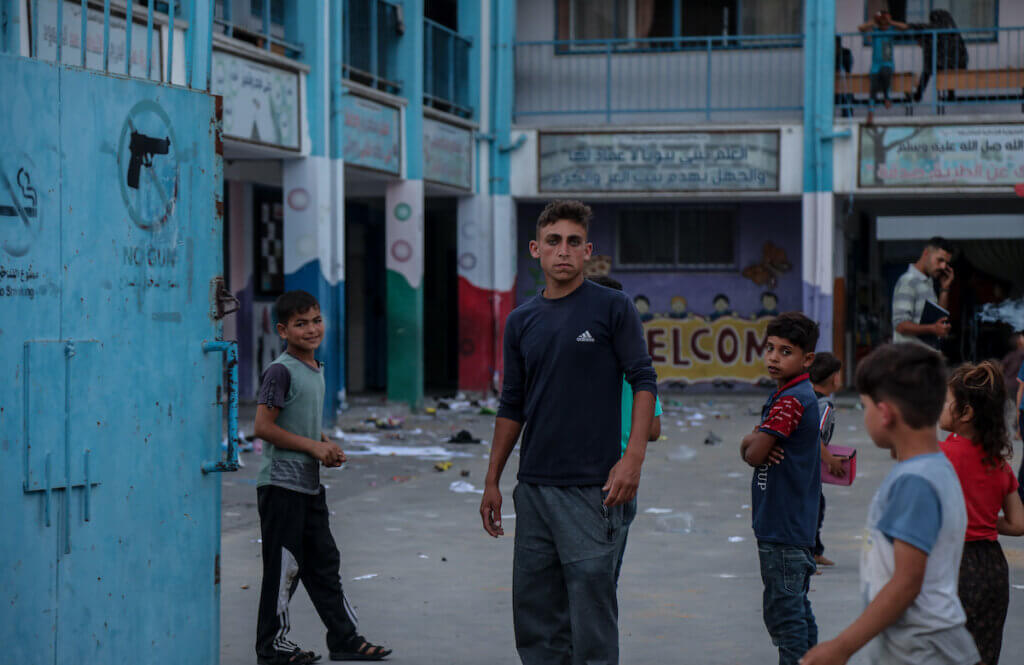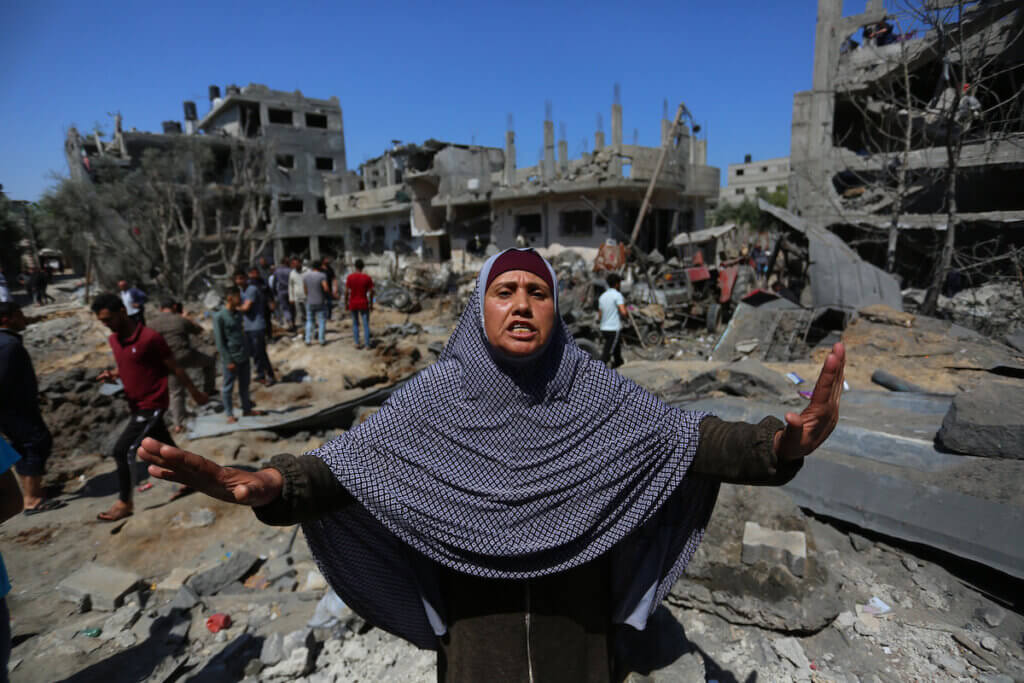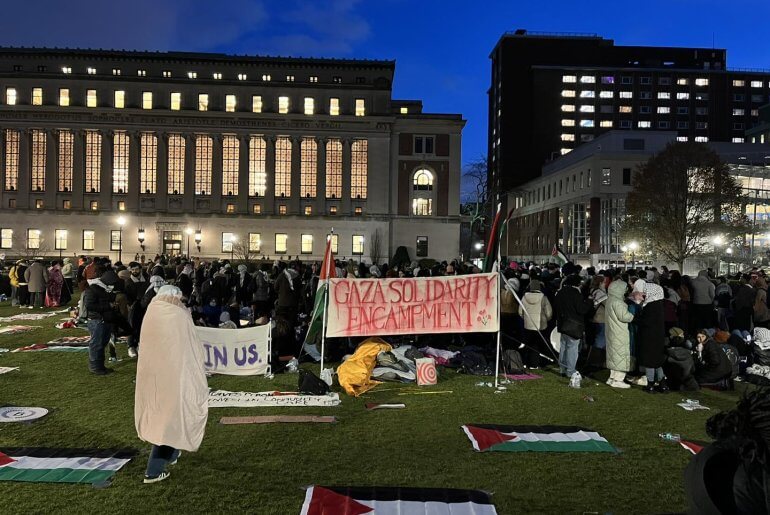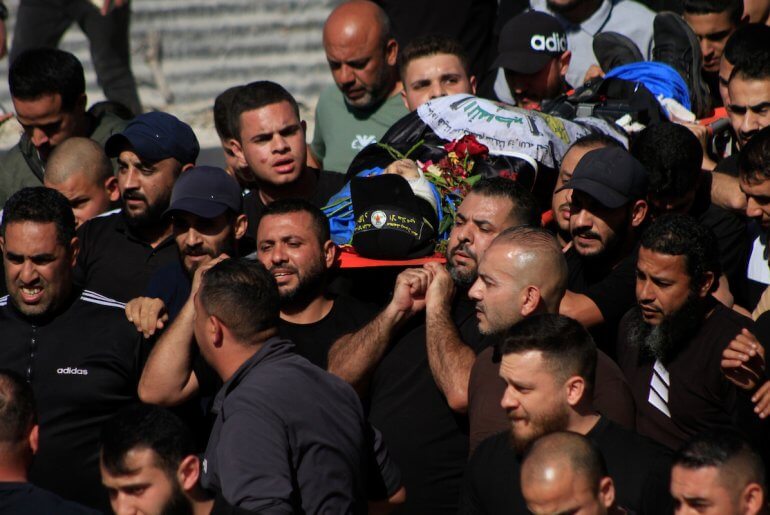At least 38,000 Palestinians have fled their homes and sought shelter in schools run by the United Nations as hundreds of houses were completely destroyed in airstrikes since last Monday, in the most serious escalation in Gaza between Israel and Hamas in the past seven years. Most were displaced beginning late last week when ceasefire negotiations failed, and Israeli forces carried on with an air campaign and Palestinians launching rockets into Israel.
In Shuja’iyya, a neighborhood of 100,000, Palestinians grabbed what they could and ran through the streets westward towards the coast early Friday evening, away from the border with Israel and the sounds of blasts from tanks.
“I held my kids who can’t run . . . I carried them all in my arms and started to run to the west.”
“I held my kids who can’t run, Marah who is 2 years old, Jameela who is 4 years old, and Rabab who is 6 years old,” Ahmed Raffeq, 35, said. “I carried them all in my arms and started to run to the west.”
“It was evening almost 9 o’clock, and it was like a doomsday,” he recounted. “Thousands of people fleeing, on feet, cars, donkey cars, trucks. I saw a man with four kids on a motorcycle.”
Of those sprinting in the streets, “most of them were barefoot” he said, “and in the background were bombs shaking us every few minutes.”

The night sky was dark, except for flashes of orange from bombardment in the air and festive lights still strung in the streets for the Muslim Eid holiday that took place the night before.
The Raffeqs lives on al-Mansoura Street, the last boulevard before the open field that makes up the buffer zone with Israel. It stretches 300 yards at its narrowest, extending up to a mile. “It started with heavy shelling fired randomly near us” Raffeq, said describing Israeli tanks firing from across the border. Most of the artillery struck “in empty lands around us, they wanted to terrify us,” he said.
The firing began “at sunset,” he recounted. “So many sounds for different weapons were heard: warplanes, artillery, flash bombs, and another sound we were hearing for the first time,” he described. A sound so loud, “it could explode your head.”
“The people who fled first warned others,” Raffeq said. Residents remembered the 2014 war where entire tracks of Shuja’iyya were leveled in Israel’s ground operations. The neighborhood was the flashpoint for violence and fighting that resulted in some of the deadliest days of that two-month escalation. Fearing a similar onslaught of violence loomed, many grabbed what they could and darted west.
Earlier that day the Raffeq’s made go-bags filled with clothes, food, and important documents such as ID cards, in anticipation the family may need to head to a shelter without notice.
“We are unarmed and have kids and women with us. So we had to flee, for now, then we can decide to go back or stay away from our homes,” Raffeq said.
Others, in less populated areas, were unaware their neighbors had abandoned their homes in mass.
“I cut short my prayers to answer the door, which was not nicely knocked on,” Hani Rabah, 51 said. When the father of eight heard shouting on the other side, he “immediately knew that this will never be good.”
“In a frighteningly loud and shaking voice, and bloodshot eyes, my neighbor said to me “get your family and leave now, there is no time!”
“In a frighteningly loud and shaking voice, and bloodshot eyes, my neighbor said to me “get your family and leave now, there is no time, hurry up!” Rabah said. “He gave me an overdose of fear, fear for my kids.”
“What can you gather in minutes from a home that you spend 50 years in?” Rabah asked. Two of his older children scooped up his youngest four. “I told them to bag some necessary stuff for the unknown trip, I told my wife to bring the new clothes the kids got on Eid, and I woke them up telling them that we are going to an Eid party,” he explained.
“They bought it. And that helped, but was heartbreaking,” the father said.
The family of 10 are now holding up in a room in a relative’s house, who also opened up a separate room for a family of seven to take cover.
“Twenty-three people inside a small flat of three rooms, half of them children,” Rabah said. “Except the kids, no one could sleep at night, and the children who do sleep, they wake up terrified with each blast,” he continued.

Hospitals, schools, and media bureaus destroyed in airstrikes
Since fighting began seven days ago, 212 Palestinians have been killed and ten Israelis. In Gaza, 94 buildings, including at least 16 residential and commercial high-rises were destroyed in airstrikes, accounting to the Palestinian ministry of public works and housing. An additional 284 were damaged, causing 2,500 to become homeless.
On Sunday the Al Jalaa tower, a 12-story building situated in a densely populated area of Gaza City, was completely destroyed in an airstrike around one hour after the Israeli military issued a warning. The tower held Gaza bureaus of many international media outlets including Al Jazeera and the Associated Press. The roof of the building was a common location for television reporters to stand for live broadcasts.

AP President and CEO Gary Pruitt released a statement over the weekend, stating “we narrowly avoided a terrible loss of life” as “a dozen of AP journalists and freelancers were inside the building” moments before the strike.
“We are shocked and horrified that the Israeli military would target and destroy the building housing AP’s bureau and other news organizations in Gaza,” he said. “They have long known the location of our bureau and knew journalists were there.”
The Israeli government told the wire service that the tower included an office used by Hamas. “We have called on the Israeli government to put forward the evidence. AP’s bureau has been in this building for 15 years. We have had no indication Hamas was in the building or active in the building. This is something we actively check to the best of our ability. We would never knowingly put our journalists at risk,” Pruitt said.
According to the United Nations, in the last week 41 schools, six hospitals, and three health clinics were damaged, and one medical clinic was completely destroyed.
For the seventh day, Gaza’s only desalination plant has not operated, cutting off piped water to 250,000. Separately, for the last four days, another 230,000 Palestinians lost piped water due to electrical shortages. With feeder lines destroyed to Gaza’s only power plant, households only have electricity for up to eight hours a day.
Airstrikes also damaged around 250 yards of the coastal enclaves sewage network, and one landfill was hit. The United Nations released a flash statement on the damage, reporting “The largest storehouse for agricultural pesticides in Gaza was also bombed.”
According to the Israeli military, as of Saturday Palestinian armed groups in Gaza fired over 2,300 rockets at Israel, and Israeli forces struck over 800 sites in Gaza.
Among the most deadly airstrikes are instances where several members of the same extended family were killed.
On Saturday 10 members of the Abu Hatab family were killed in a single airstrike in al-Shati refugee camp, killing two women and eight children.

Last Monday around 6 p.m., eight members of the same family, including two children age 1 and ten, were killed in a series of blasts in the northern village of Beit Hanoun. At the time of the airstrike, fighting had just begun and the family was outdoors harvesting at their farm.
The children, said Amana al-Masri, the mother of 10-year old Rahaf al-Masri who died in the third blast, “were together, playing in front of the house, happy and vital, knowing no harm.”
“In a second they burned. Please I need anyone to tell me the reason of this?” she said, describing her child’s and nephew’s killings.
“They were supposed to grow old, go to school, have friends and family, know life and live a little, but Israel killed them preventing them to live,” she said.
Tareq S. Hajjaj
Tareq S. Hajjaj is a freelance journalist and a member of Palestinian Writers Union. He studied English Literature at Al-Azhar university in Gaza. He started his career in journalism in 2015 working as news writer/translator at the local newspaper Donia al-Watan. He has reported for Elbadi, the Middle East Eye, and Al Monitor.




Fascistic, racist, murderous Israel in action:
Israel kills children, doctors in horrific nighttime massacre (israelpalestinenews.org)
“Israel kills children, doctors in horrific nighttime massacre”By Tamara Nassar, reposted from The Electronic Intifada
BRIEF EXCERPT:
“Israel in the early hours of Sunday night obliterated multiple generations of families when it bombed their homes in Gaza.
“Around 1 am, Israeli warplanes launched a savage bombing campaign lasting at least an hour, firing 50 missiles at the area surrounding al-Wihda street in Gaza City.
“Without warning, the bombs hit residential buildings, bringing them down on top of those inside.
“The death toll from the attack has risen to 42, including 10 children and 16 women. Fifty more were wounded.
“Two prominent doctors were among the dead.
As of Sunday evening, rescuers were still searching for survivors under the rubble.
“This has raised the death toll in Gaza since Israel’s bombing campaign began last Monday to at least 192, including 58 children and 34 women, according to the health ministry in the territory.
“More than 1,200 people have been injured.
“In the attack, early Sunday, multiple generations of the al-Qawlaq family – at least 17 people – were killed. The youngest victim, Qusay Sameh al-Qawlaq, was 6 months old, and the oldest was 84-year-old Saadiya Yousef al-Qawlaq.
“Israel also bombed civic infrastructure, businesses, and the main roads leading to the city’s al-Shifa hospital, according to Al-Mezan, a human rights group in the territory.
“An official from Gaza’s health ministry said Israel deliberately targets roads, preventing wounded Palestinians from getting medical care.”